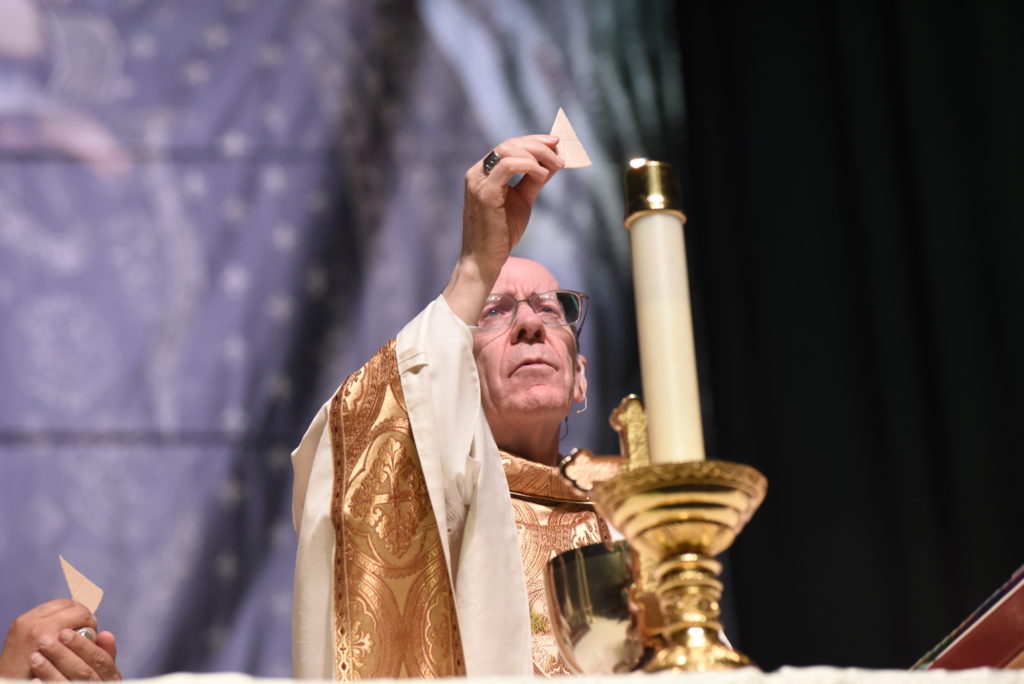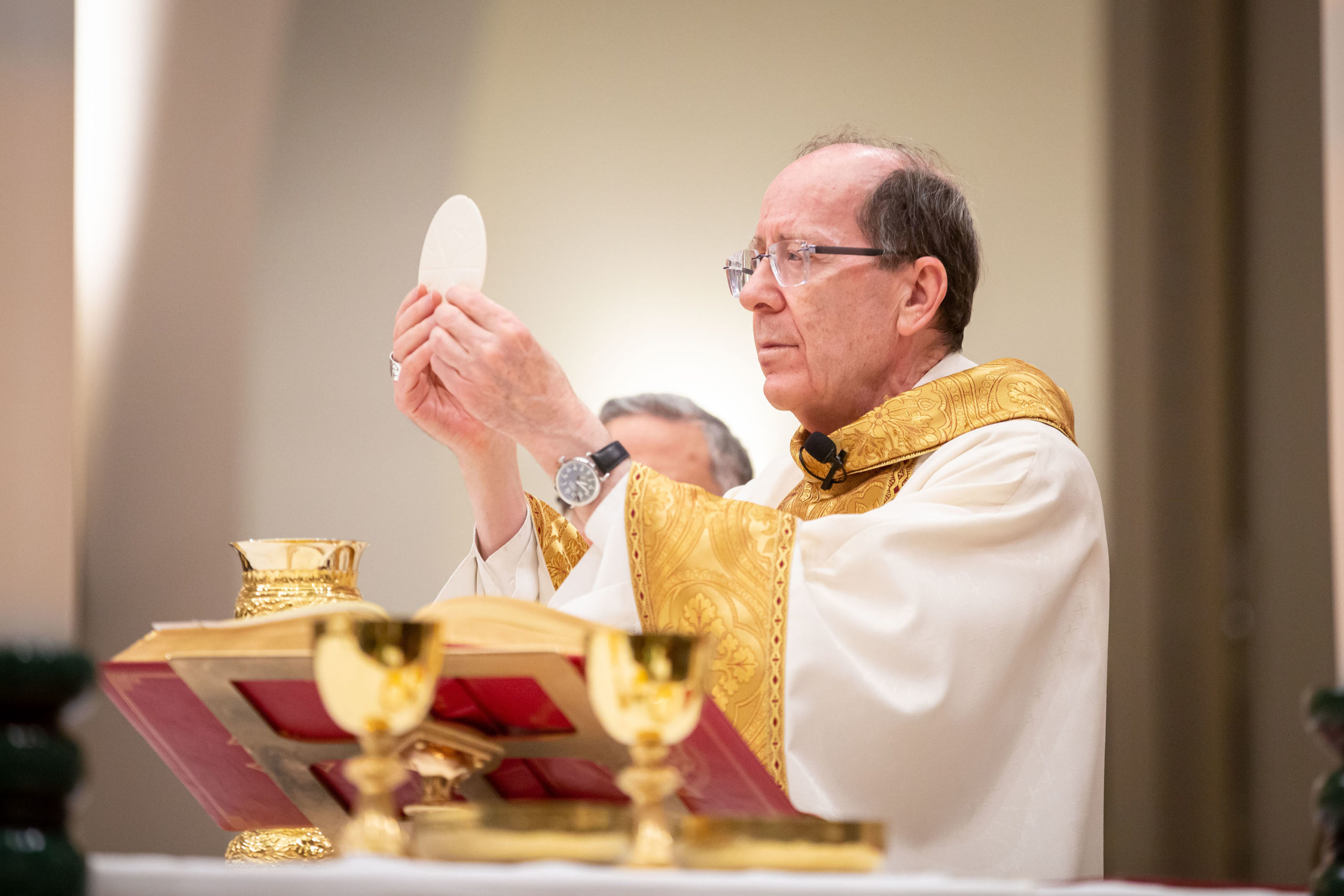With the grandeur of Holy Thursday serving as a focal point, Bishop Thomas J. Olmsted of the Diocese of Phoenix has issued a landmark Apostolic Exhortation on the centrality of the Eucharist.
The nearly 14,000-word document, “Veneremur Cernui – Down in Adoration Falling,” delves into the key history and theology as well as the beauty of the Eucharist. In language both practical and, at times, poetic, the Apostolic Exhortation calls upon priests and laity to embrace a deeper love for and understanding of the Eucharist as the source and summit of the Catholic faith.
Read “Veneremur Cernui – Down in Adoration Falling”
Holy Thursday, which commemorates the Institution of the Eucharist, seemed the perfect backdrop for the issuing of the Apostolic Exhortation. “I as your shepherd implore each of you to seek out Jesus in the Eucharist to be strengthened and renewed in your faith,” Bishop Olmsted writes.
A vivid personal narrative near the beginning of the document describes the bishop’s upbringing in an ardently Catholic family that prayed together daily. From the reverence his parents showed and the witness of their pastor, he wrote, “a solid conviction about the real presence of Jesus in the Eucharist” was imbedded in his heart.
In setting the stage for the Apostolic Exhortation, Bishop Olmsted acknowledges the “grave crisis of faith in the Eucharist” the Church is experiencing at present. From declining vocations to the priesthood, marriage and religious life to “abysmal Mass attendance” and attacks on the truths of the faith, he notes that “in such troubled waters, our greatest anchor in these storms is Christ Himself, found in the Holy Eucharist.”
Divided into three parts, “Veneremur Cernui – Down in Adoration Falling,” takes its title from the words of Tantum Ergo, the hymn composed by St. Thomas Aquinas in the 13th century which illuminates the mystery of the Eucharist. References to hymns composed by the revered theologian and Doctor of the Church are sprinkled throughout the text of the Exhortation.
“There’s a lot of really good devotional music that moves your heart — English, Spanish, Vietnamese, whatever language it is — but in terms of music that is really linked to the great mystery of the Eucharist, Thomas Aquinas’ has stood the test of the ages,” Bishop Olmsted said of the references.
Eucharist – Mystery to be revered
The first part of the Apostolic Exhortation explores the history of the Eucharist, laying the groundwork by describing how Jesus Christ brought the first Passover experienced by the Israelites to ultimate fulfillment at the Last Supper.
“Jesus meant exactly what He said — He is truly present in the Eucharist.”
“At the Last Supper, which the Church commemorates today, Jesus took part in and forever transformed the Jewish Passover ritual meal,” Bishop Olmsted writes.
Objections that Christ’s words at the Last Supper ought to be understood as merely symbolic are deftly dealt with in the Apostolic Exhortation.
“Jesus meant exactly what He said — He is truly present in the Eucharist,” the bishop writes. “…if Jesus had meant it as a symbol, He would not have repeated this message seven times in this dialogue… Despite the uproar caused by His teaching, Jesus did not soften His claim. On the contrary, He strengthened it.”
As early as the second century, the Exhortation explains, Christians were “accused of cannibalism by the pagan Romans because they ate and drank the Body and Blood of Christ.” This belief in the Real Presence of Christ in the Eucharist has been a dividing point since the Protestant Reformation but belief in the True Presence is expressed by the early Church Fathers, including St. Justin Martyr, born around the year 100 AD.
And though Eucharistic theology can prove challenging for those who haven’t studied it, the Exhortation breaks down the basics, rendering it approachable for the layman.
Whenever the Mass is celebrated, Bishop Olmsted explains, “the sacrifice of Jesus on Calvary that happened in the past is really made present to us at Mass, here and now.” The sacrificial love that Jesus showed by His self-offering on the cross is an eternal sacrifice that transcends time and is present to the faithful at every Mass throughout time.
“A lot of our people don’t know that,” Bishop Olmsted said, explaining that he had priests well-versed in theology and liturgy working alongside him in developing the Exhortation. “We had the feeling that we really needed to give a good section of just good clear teaching, scripturally, catechetically and from the history of the Church itself.”

Hold nothing back from Christ
In the second part of the Apostolic Exhortation, Bishop Olmsted explains that the Eucharist is “truly the sacrament of Christ’s love” and encourages the faithful “to go all out” in their response to “Jesus’ most extravagant gift of Himself.”
In consuming the Eucharist, “a Christian becomes truly what he eats; he is transformed into Christ” and is invited to accept “Jesus’ invitation to walk the same path of sacrificial love.” Bread and wine themselves are powerful symbols of what sacrificial love entails; from the harvesting, thrashing, crushing, grinding, kneading and baking to the plucking and smashing of grapes, we see a foretelling of the agony Jesus suffered in His Passion and Death. “This is what true love really means. Every time we come to the Eucharist, we are invited to imitate this sacrificial love of Christ,” the Exhortation states.
“This is what true love really means. Every time we come to the Eucharist, we are invited to imitate this sacrificial love of Christ.”
There’s an inspiring passage that details the tremendous courage of the late Cardinal Francis Nguyen Van Thuan, the Vietnamese prelate who spent 13 years in prison, nine of them in solitary confinement. The Masses he risked celebrating in secret consoled fellow prisoners and even converted non-Christians.
Loving and Eucharistic Lord
The third part of “Veneremur Cernui – Down in Adoration Falling” contains practical suggestions for both priests and laity regarding the Eucharist. Bishop Olmsted is encouraging lay Catholics to attend daily Mass, spend time in Adoration and honor Sunday as the Lord’s Day, enumerating specific ways to accomplish those ideals.
He quotes the Catechism of the Catholic Church to underscore the significance of the Sabbath. “Sunday is a ‘day of protest against the servitude of work and the worship of money’ (CCC 2172) the bishop writes. “Sunday is the time to herald to the world that we are no longer slaves to sin and death. This day is meant to be a weekly gift from God to His people: a day of freedom, joy, charity and peace.”
Bishop Olmsted addresses his brother priests, encouraging them to make the Eucharist the source of their priestly fruitfulness, setting aside time before the Blessed Sacrament each morning before engaging in pastoral work, having a Eucharistic Holy Hour daily and celebrating Mass each day. He also wants them to “start or join a Jesus Caritas group to provide fraternal love and support ordered around Jesus’ eucharistic love for His priests.” A call to pastors to make eucharistic adoration more available and to organize yearly eucharistic processions at their parishes is another key element of the document.
“Veneremur Cernui – Down in Adoration Falling” is the third Apostolic Exhortation issued by Bishop Olmsted. “Into the Breach,” challenging men to embrace virtuous living and fatherhood, was issued in 2015. “Complete My Joy,” on the call to holiness in marriage and the family, was released in 2018.
—
Webinar with Bishop Olmsted
On Tuesday of Holy Week, Bishop Olmsted spent time reflecting on his new Apostolic Exhortation during a webinar event, encouraging Catholics to walk more closely with God, to spend time with Him in prayer, and urging people to keep Sunday as a day to cherish with the Lord. Watch the replay here: https://attendee.gotowebinar.com/recording/4949644420957700611







